Everyone who lives with endometriosis as a patient, or as a family member, partner, or friend of a patient, has something (or sometimes many things) they wish for, with respect to this disease. In March, as part of their Endometriosis Awareness Month activities, The Endometriosis Network Canada asks people from across Canada to send them their wishes with the hashtag #awishnoted, which is an anagram for “what is endo?” These wishes are displayed as a digital “wall of wishes,” and as an actual physical wall at the Endomarch Canada event in Toronto. Wishes range from wanting better medical care, to wishing for a baby, to wishing for continued strength while dealing with endo.
I also have an endometriosis wish, and it is a big one. But as William Arthur Ward said: “If you can imagine it, you can achieve it.” My wish starts with all teenagers being educated about the signs and symptoms of endometriosis, so that people would be aware of the possibility of endometriosis as soon as they start developing symptoms. The primary care practitioners would also be educated about endo, and would refer to a specialist when they suspect the disease.
The specialist care would be delivered at a multidisciplinary centre of expertise in endometriosis. This care would include the appropriate medical expertise, such as skilled excision surgeons, and other medical specialties as required, such as urology and gastroenterology. In addition, endometriosis patients would receive care from women’s health physical therapists and nutritionists, and other alternative/complementary medical practitioners as needed. Pain management specialists would also be an option for care if required. Counselors would be available to help patients deal with the emotional impact of the disease, and patients would be referred to support groups, for peer support from others who are dealing with endometriosis.
As if that isn’t enough to be wishing for, I also wish that the general public had a much greater awareness of endometriosis, how devastating it can be, and how wide-reaching the emotional effects are. If this were the case, in addition to receiving excellent healthcare at a centre of expertise, endometriosis patients would also receive better support from people in their daily lives.
However, the reality of living with endometriosis today is far different from this vision of what could be. In my work with The Endometriosis Network Canada, I am privileged to interact with many endometriosis patients. They are all incredibly strong people who continue to fight for a better quality of life, on a daily basis, despite all the obstacles around them. Many of them fought for years to obtain a diagnosis, usually hearing along the way from doctors “there is nothing wrong with you,” or “your problems are not physical, they are in your head,” or “I can’t/don’t know how to help you.”
Even once endometriosis has been diagnosed, often the care women have received is horrifying. I have talked to women who have been butchered by inept surgery, suffered complications that could have been avoided, or who have had unnecessary hysterectomies during surgeries that are supposed to treat endometriosis, where all or most of the endometriosis was left in the body but healthy organs were removed. Many endometriosis patients have been refused care by specialists, for reasons unknown. Some have been offered anti-psychotic medication or sedatives instead of painkillers, as a “treatment” for endometriosis or chronic pain. My vet once commented to me that animals receive better care than women with endometriosis.
For many endometriosis patients, they have no support network around them. They may have partners, family, and friends who do not understand the medical effects of endometriosis, and definitely do not understand the emotional consequences of living with chronic pain and other debilitating symptoms. Some have lost jobs, partners, and custody of their children as a consequence of their disease. Many are depressed and anxious, or worse, suicidal.
This state of affairs is not ok. We are capable of doing more for people with endometriosis, except that not enough people care about the current state of affairs for things to start changing. It is hard for me to imagine that if most people really knew about what life is like for many people with endometriosis, they would be ok with abandoning over 176 million women worldwide to this kind of suffering and medical mismanagement.
This is why March, as Endometriosis Awareness Month, is important. Most people with endometriosis face the task all year long of educating those around them about their disease. However, in March, endometriosis patients come together, and make their voices heard even more loudly, as a united group. We are tired of suffering and being ignored. We want people everywhere to understand what endometriosis is and why it is a major healthcare crisis, and we want people to care enough to start demanding the changes in our education system, in our medical education system, in our insurance systems, and in our healthcare delivery systems, that would make my wish become a reality.












Nancy, I hope you feel better soon. It is an exhausting journey sometimes. I will add your wish to our digital wish wall!
Breaking**
I wish for better treatment and recognition of the seriousness of endometriosis. I wish that girls would be diagnosed so much sooner. It took 13 years of symptoms for them to finally make my diagnosis. 13 painful years. Each year the symptoms increased. The last 3 of those years went beyond just monthly pain and progressed to constant pain. I still deal with the pain of secondary conditions caused by Endo. Pelvic Floor Dysfunction and Interstitial Cystitis. Working with a physical therapist to get my life back. Here’s to hoping for pain free days in the future. So grateful the endometriosis portion of the pain is gone, but I am ready for it ALL to be gone! It puts so much strain on me mentally, emotionally, and physically. It pushes me to braking points at times. I will get there. Now that the Endo is gone I can focus on the rest and take my life back! I wish to spread the message because I don’t want this for our future generations of girls! #awishnoted #EndEndo